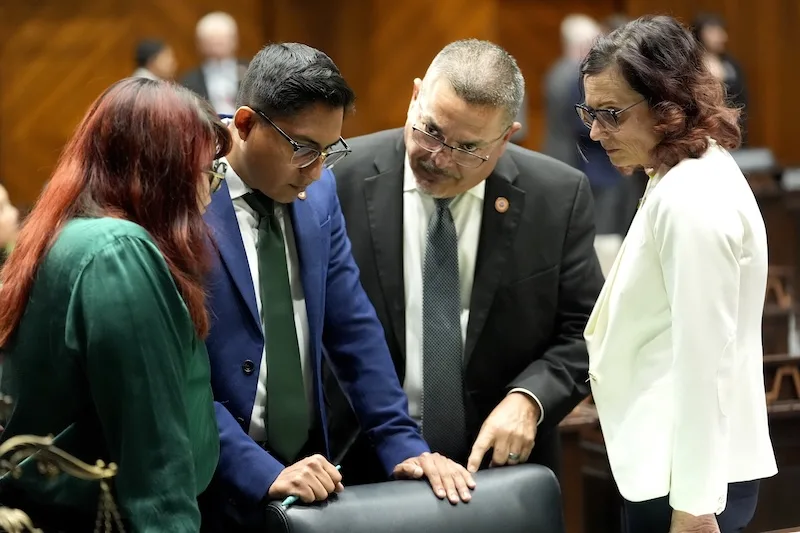
Photo by Jake Hines
Three-quarters of American workers cannot work from home during the pandemic, putting them at increased risk of exposure to COVID-19.
As the number of cases and deaths continue to rise in Arizona, public agencies across the state are seeing COVID-19 outbreaks within their ranks, from police departments to county health departments.
Pima County announced last week that the director of public health had tested positive for COVID-19, as part of an apparent outbreak in the health department. At least 11 employees in the department had tested positive.
More than 300 Pima County employees had tested positive for COVID-19 since the start of the pandemic, with 20% contracting the virus in the past two weeks, according to County Administrator Chuck Huckelberry.
In Maricopa County, Police Chief Jeri Williams and Executive Assistant Chief Michael Kurtenbach both tested positive for COVID-19, according to the Phoenix Police Department.
12 News reported last week that nearly 500 Phoenix police officers and staff have tested positive since the start of the pandemic. Approximately 20% of those employees were quarantining as of last Monday.
The outbreaks come as the state continues to report rising cases of COVID-19 cases and deaths. Arizona reported 10,086 new cases of COVID-19 and 42 new deaths on Monday.
In recent weeks, Gov. Doug Ducey and Arizona Department of Health Services Director Dr. Cara Christ have both contended that the primary source of community spread of the virus is occurring at private gatherings.
But contact tracing efforts by Pima County found that, in a sample of 3,273 people who tested positive for COVID-19, almost two-thirds reported having to work outside of their home, many at healthcare facilities, schools, or daycares. Only 15% of people reported recently attending a gathering with 10 or more people.
Pima County’s Chief Medical Officer Dr. Francisco Garcia said the outbreak in the county’s health department was the result of substantial spread of the virus throughout the community.
“The virus can get into your homes and places of work any number of ways no matter how vigilant you are being with your precautions,” Garcia said in a statement.
Three-quarters of American workers—or 108 million people—cannot work from home during the pandemic, and are therefore at increased risk of exposure to COVID-19, according to a study by University of Washington professor Dr. Marissa Baker.
Baker said the pandemic has forced people to decide between going back to work and earning a paycheck, or staying home to prioritize their personal health and the health of their families.
“That’s a choice no worker should ever have to make,” she said. “That’s what many people are being asked to do.”
How Can We Keep Workers and the Public Safe?
Early on in the pandemic, states and municipalities used stay-at-home orders as the backbone for controlling the spread of coronavirus.
“That’s really hard for a lot of people,” Baker said. “The people that it’s the hardest for also tend to be the people who are paid the least.”
Many workers who are unable to work from home often lack protections like employer-provided health care, appropriate sick leave, or paid time off, which makes them more vulnerable during a public health emergency like the current pandemic, Baker’s study found.
Baker says that workplaces have not received any official directives from the Occupational Safety and Health Administration (OSHA), the federal agency that inspects and examines workplaces for safe working conditions.
Instead, Baker says OSHA only provides guidance for employers on how to keep their employees safe during a pandemic.
These guidelines include explaining to employees which job activities may put them at risk for exposure and their remote work options.
Baker, who studies exposures in the workplace and how to keep people safe at work, says employers can do more, including by ensuring that employees stay home when they’re sick or when they’ve been exposed.
Employers should make sure employees have ample access to sick leave, but more importantly, employees should feel like they can use their sick leave without fear of retribution or retaliation from their employers, she said.
Oftentimes employees feel like they are the only ones who can do their jobs, or are worried that they’ll be laid off if they use their sick leave.
“There needs to be enough [sick leave], but they need to be encouraged to take it,” Baker said.
More Federal Assistance On The Way
Baker also says the government should be paying workers to stay at home to curb additional spread of the virus.
Baker’s study found that workers with the lowest average median wage cannot work from home. The stress of the pandemic, coupled with job insecurity, could result in a large burden of mental health disorders among these workers, in addition to increased risk of workplace transmission of the virus, she wrote.
At the start of the pandemic, the federal government signed the CARES Act, which provided a one-time payment of $1,200 for Americans impacted by the pandemic, as well as an extra $600 in unemployment benefits.
But while the pandemic has continued, the $600 unemployment boost expired in July.
President Donald Trump signed the new COVID-19 relief bill into law on Sunday, ensuring that qualifying Americans will receive stimulus checks of at least $600. The bill will also provide additional federal unemployment benefits of $300 through March 14.
To keep Americans safe, Baker said federal safety nets should be providing more relief to businesses, allowing them to shut their doors and keep their employees home, while still staying afloat financially.
“There are jobs that have to happen, there are people who have to go to work,” Baker said. “That’s why it’s important for people who can stay at home and do not have to go to work…to do what they can to protect the people who do have to go to work.”
Has there been a COVID-19 outbreak in your workplace? Let reporter Lorraine Longhi know at [email protected] or 480-243-4086.
Politics

Democrats clear path to bring proposed repeal of Arizona’s near-total abortion ban to a vote
Democrats in the Arizona Senate cleared a path to bring a proposed repeal of the state's near-total ban on abortions to a vote after the state's...

It’s official: Your boss has to give you time off to recover from childbirth or get an abortion
Originally published by The 19th In what could be a groundbreaking shift in American workplaces, most employees across the country will now have...
Local News

Kari Lake calls on Arizona county sheriffs to enforce 1864 abortion ban
Republican candidate for US Senate Kari Lake on Saturday seemed to solidify her support for Arizona’s total abortion ban and called on county...

Where to buy farm-fresh eggs in Tucson
Once you’ve tasted farm-fresh eggs, it’s hard to go back to the store-bought variety. Not only do farm-fresh eggs taste better and have...




